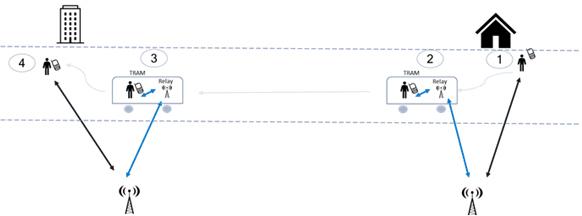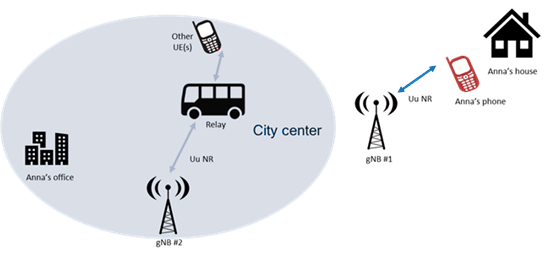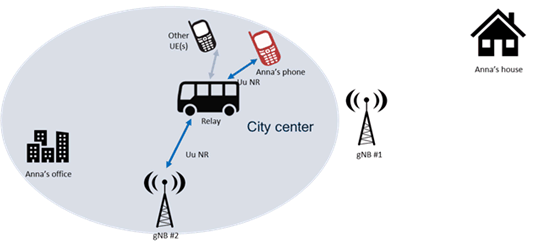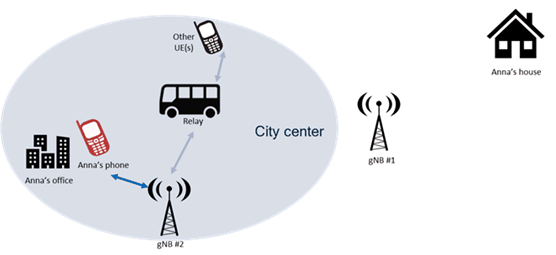Content for TR 22.839 Word version: 18.1.0
5.11 Use cases on Service continuity
5.11.1 Mobility between macro and relay
5.11.1.1 Use case 1: User entering/leaving the vehicle
5.11.1.2 Use case 2: User outside the vehicle
...
...
5.11 Use cases on Service continuity p. 23
5.11.1 Mobility between macro and relay p. 23
5.11.1.1 Use case 1: User entering/leaving the vehicle p. 23
5.11.1.1.1 Description p. 23
When users/UEs enter or leave vehicles with on board relays, handover between macro and vehicle relays can happen, if an active connection is ongoing.
The scenario described in this use case refers to a user, Alice, engaged in a phone call while going to her office via tram.
5.11.1.1.2 Pre-conditions p. 23
Alice is at a tram station, waiting for her usual 8am tram to get to her office, located several miles away.
The tram happens to be equipped with an on board base station relay, offering 5G connectivity from the same HPLMN as Alice is subscribed to.
Before the tram arrives, Alice calls her secretary to discuss the busy meetings schedule of the day, using available radio coverage from her HPLMN macro network.
5.11.1.1.3 Service Flows p. 24
- Alice is at the tram station, with an ongoing call using macro 5G network (from her HPLMN)
- The tram arrives, and Alice enters the vehicle. Given the very good 5G relay coverage inside, much better than the macro NW, the call is handed over via the relay, without any discontinuity.
- The tram arrives at Alice's office location, and the call is still ongoing, via the tram relay.
- Alice leaves the tram; while exiting, the 5G connection switches back from the tram relay directly to the macro network, and the call continues seamlessly.

5.11.1.1.4 Post-conditions p. 24
While walking to the office building, Alice thanks her secretary for the helpful de-brief and hangs up; she feels very well prepared for the busy working day ahead.
5.11.1.1.5 Existing features partly or fully covering the use case functionality p. 24
Current requirements (e.g. related to wireless self-backhaul, see clause 6.12 of TS 22.261) or existing functionalities (e.g. IAB), cover scenarios of autonomous configuration/adaptation of network topologies, but do not assume or fully address physical relay mobility.
5.11.1.1.6 Potential New Requirements needed to support the use case p. 24
[PR 5.11.1-1]
The 5G system shall be able to support efficient handover when a UE active communication changes from the macro network to a mobile base station relay (e.g. mounted on a vehicle) and vice versa, ensuring end-to-end service continuity during mobility of the UE (e.g. entering or leaving the vehicle) and/or the relay.
5.11.1.2 Use case 2: User outside the vehicle p. 24
5.11.1.2.1 Description p. 24
When moving to an area where coverage from mobile base station relay(s) is available, the UE can be handed over from the macro network to a suitable mobile base station relay. Conversely, when the UE served by a mobile base station relay is heading out of the area where coverage from mobile base station relay(s) is available, the UE can be handed over from the relay to the macro network. In both cases, ensuring that there is no interruption in the ongoing services at the UE will yield an improved user experience.
5.11.1.2.2 Pre-conditions p. 24
Anna lives in a residential area within walking distance of the city center. She gets good 5G service from the macro network around her house thanks to the lack of tall buildings and the fact that the area is not densely populated. Anna works in the city center and likes to go to the office on foot. Often, to save time, she takes conference calls on her way to work.

5.11.1.2.3 Service Flows p. 25
(1)
It's 7:55 am and Anna gets out of her house to walk to work. She has a conference call at 8 am so she starts the conferencing app on her phone and connects her headset.
(2)
At 8:25 am, Anna arrives in the city center. Anna's boss asks her to give an update on the project she is working on. Anna starts giving her presentation.
(3)
Due to the high-rise buildings in the center, the macro coverage gets spotty, and due to the high number of UEs, the data rate allocated to Anna's phone starts going down. Anna's boss starts asking her questions on the updates she has presented.
(4)
Traffic in the center is very packed and there are buses equipped with mobile station relays on the avenue where Anna is walking. The macro network determines that Anna's phone can get better coverage from a relay than from the macro and hands over Anna's phone to the relay in the bus closest to Anna. All ongoing services in the phone, including the conference call, are transferred without service interruption.

(5)
Anna's phone regains good coverage and maximum data rate, enabling Anna to not miss any of her boss's questions and to provide answers. Anna's boss congratulates her for the good progress on her project.
(6)
Anna's conference call continues and her colleagues give updates on their own project. Anna arrives in front of her office building and enters the building, while the bus in which the relay is installed continue alongside the avenue
(7)
The network determines that the serving relay and Anna's phone are moving in diverging directions and hands over Anna's phone the macro cell serving Anna's office building. All ongoing services in the phone, including the video call, are transferred without service interruption.

(8)
Anna finishes her conference call, and goes to her office.
5.11.1.2.4 Post-conditions p. 26
Anna's conference call was transferred seamlessly from the macro network to the mobile base station relay and then back to the macro network.
Anna is very pleased that she was able to participate in the call without service outage, which enabled her to complete her presentation, answer all questions, and listen to her colleagues' updates.
5.11.1.2.5 Existing features partly or fully covering the use case functionality p. 26
Current requirements (e.g. related to wireless self-backhaul, see clause 6.12 of TS 22.261) or existing functionalities (e.g. IAB), cover scenarios of autonomous configuration/adaptation of network topologies, but do not assume or fully address physical relay mobility.
5.11.1.2.6 Potential New Requirements needed to support the use case p. 26
[PR 5.11.1-2]
The 5G system shall be able to support efficient handover when a UE active communication changes from the macro network to a mobile base station relay (e.g. mounted on a vehicle) and vice versa, ensuring end-to-end service continuity during mobility of the UE (e.g. moving outside the vehicle) and/or the relay.